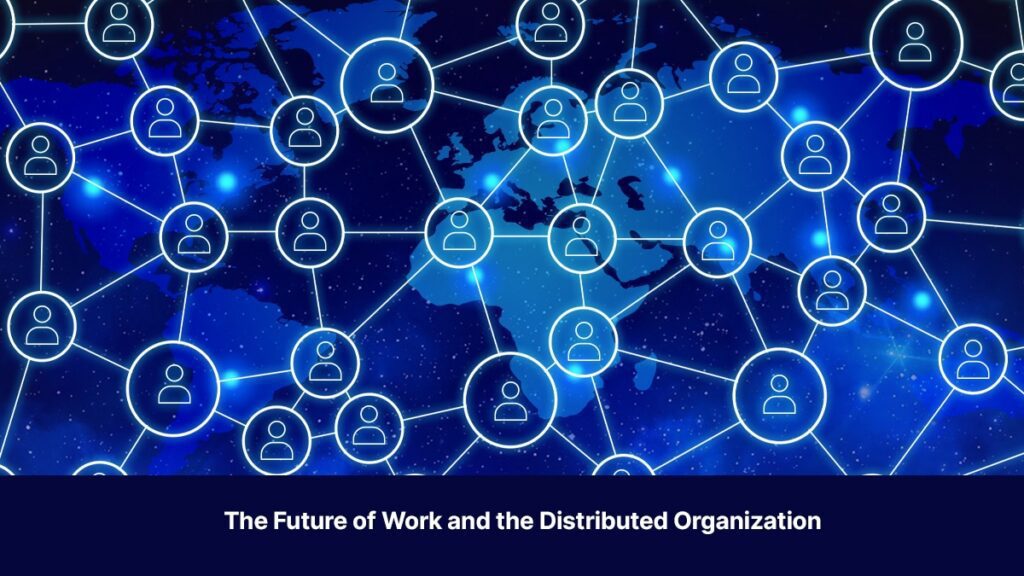The future of work will be a combination of where you work and how you work.
Organizations are struggling with the Great Attrition. Workers are rethinking their priorities and leaving their jobs in record numbers and for new reasons. In my new position paper, I explore the transformative opportunities of the emerging distributed organization and flexible work models.
The future of work is already here. It is time for businesses to reimagine what kind of organization they want to be, and create the future that is best for them.
The Choice We Face
Organizations face an immediate decision—do they stick with a highly centralized, traditional workforce design, or do they adapt to a more flexible distributed one?

The pre-pandemic organization was centralized and office based. Corporate decision-making was restricted to a few key players. Organizations controlled time and communications networks. Managers delegated tasks.
In the distributed world, the home office, or studio, enters the mix. Employees look for broader access to data, more input in decision-making, and more autonomy. Managers delegate authority and provide scope for meaningful work.
We cannot apply a centralized model to a distributed reality.
During the pandemic, technologies such as streaming, video calls, 5G, cloud computing and AI changed forever the way we work and live. Industry 4.0 went into hyperdrive! Even before the pandemic, Industry 4.0 yielded extreme connectivity, extreme automation and extreme computing power.
These technologies are powering virtual work. An estimated 90% of all professional work is taking place remotely, and many organizations have seen dramatic spikes in productivity, despite disruptions.
Yet as the world moves ahead, many businesses are struggling to figure out the future of work. They are held back by four key fallacies.

Let me dispel each of these.
Fallacy 1: There is a ‘post-pandemic.’ While COVID-19 may recede, modern work will not snap back to pre-pandemic patterns. The technology-fueled advances we have seen in human resources, security, virtual collaboration and other areas are here to stay. We are most likely living, working and loving for a decade with COVID-19.
Fallacy 2: The choice is between centralized or decentralized. The most nimble and effective teams will be neither—they will be distributed. They will leverage technology to optimize tasks that can be done remotely, while coming together in person for critical or strategic work.
Fallacy 3: I am more productive in the office. It is important to focus on “how you work”, not just “where you work.” Companies need to focus on going beyond productivity to reach optimal creativity.
Fallacy 4: Managers manage better in person. The majority of employees are far more capable of self-direction than many employers assumed. Technology is driving collaborative, inclusive relationships between managers and employees.
Businesses must move past these four fallacies, so they can seize the incredible opportunities of the distributed organization.
Talent on the Edge
In the face of the Great Attrition, firms must empower individuals. Delegate not just work but work culture. Disperse authority instead of merely assigning tasks. Employee expectations around well-being, purpose and other factors have radically changed, and leaders must respond.

Businesses also need to ensure their workers have the skills they need to excel in a distributed world.
Today, the competencies for success are massively different.
Team members need to be mentally and emotionally present, even when not working together in person. They must take initiative to connect with remote peers. They must transform virtual task-oriented teams into socially cohesive groups. And they will need grit and agility in the highly fluid virtual environments that have replaced the structured and linear world of the office.
To be successful, distributed work must be about transforming the entire organization, not just adapting to the moment. It must be done with foresight and flexibility, so that innovation thrives, and employees feel a sense of connection and purpose.
If leaders can understand what employees really need, they may be able to turn the Great Attrition into the Great Attraction.
New Tech for a Distributed World
Yesterday’s solutions will not solve today’s problems. Traditionally, centralized companies invested in software to help them gain a process advantage. Enterprise Resource Planning (ERP) was king.
Today’s world is different. Process advantage is not enough.
In a distributed world, you need to invest in the Information Advantage.
This means leveraging digital technologies to use information to its full potential. To generate insights, create new offerings, and drive predictive analysis, so businesses can thrive in the face of disruption.
OpenText is helping organizations reach this potential, by delivering Information Management in the cloud at scale. OpenText Cloud Editions includes five specialized clouds, each addressing a key business need—Content Cloud helps companies master modern work, Business Network Cloud enables digital supply chains, Experience Cloud powers modern customer experiences, Security & Protection Cloud helps build cyber resilience and Developer Cloud drives the API economy.

The distributed organization must be digital. Businesses that go all-in on digital will grow faster, be more efficient, and fuel creativity. OpenText Cloud Editions is helping them get there.
OpenText is Flex-First with Four Commitments
The distributed organization is not just theory. It is practice.
At OpenText, we will take a flexibility-first approach that will allow us to realize the benefits of a distributed model. It will be based on four commitments to each other:
- Flexibility First: Creativity happens together. Our technology teams—ranging from engineering, cloud operations, support and many others—will be together to fuel innovation 2 to 3 days a week. We believe we are better together but with more flexibility. Some roles will have even more flexibility.
- Moments that Matter: To accommodate this flexibility, our offices will be used in a purposeful way, for the times when bringing people together drives innovation, creativity, and collaboration. These moments include high-impact team meetings, ideation, complex problem solving, onboarding and critical knowledge sharing.
- Co-Investment: OpenText will invest in tools, IT kits, office re-design and other resources to help teams collaborate effectively. Employees invest in themselves in what they need for a workspace that drives both productivity and creativity.
- Co-Respect: As part of creating a safe work environment and showing respect for each other, we are requiring employees, visitors and contractors to be fully vaccinated to enter an OpenText office. Subject to government rules, employees who are not vaccinated can continue to work remotely during the pandemic.
We will continue to listen to and learn. We believe that this flexible-distributed approach will allow us to leverage the talent advantages of a broad workforce, and drive a culture characterized by creativity, empathy, grit, and purpose.
Find Your Edge
Winston Churchill once remarked, “We shape our buildings, and afterwards our buildings shape us.”
Going forward, organizations will no longer be shaped by our buildings. Rather, it will be the edges—our people, our culture, our innovations—that will shape the distributed companies of the future.
To learn more, read my new position paper, The Future of Work and the Distributed Organization.




